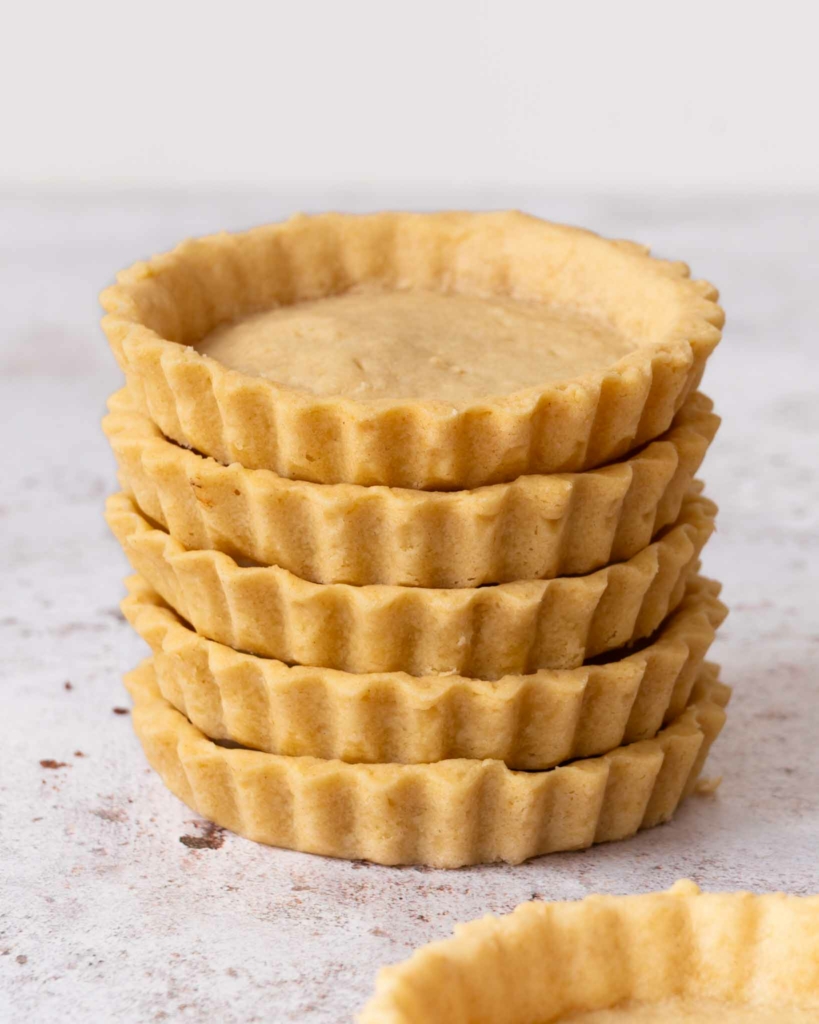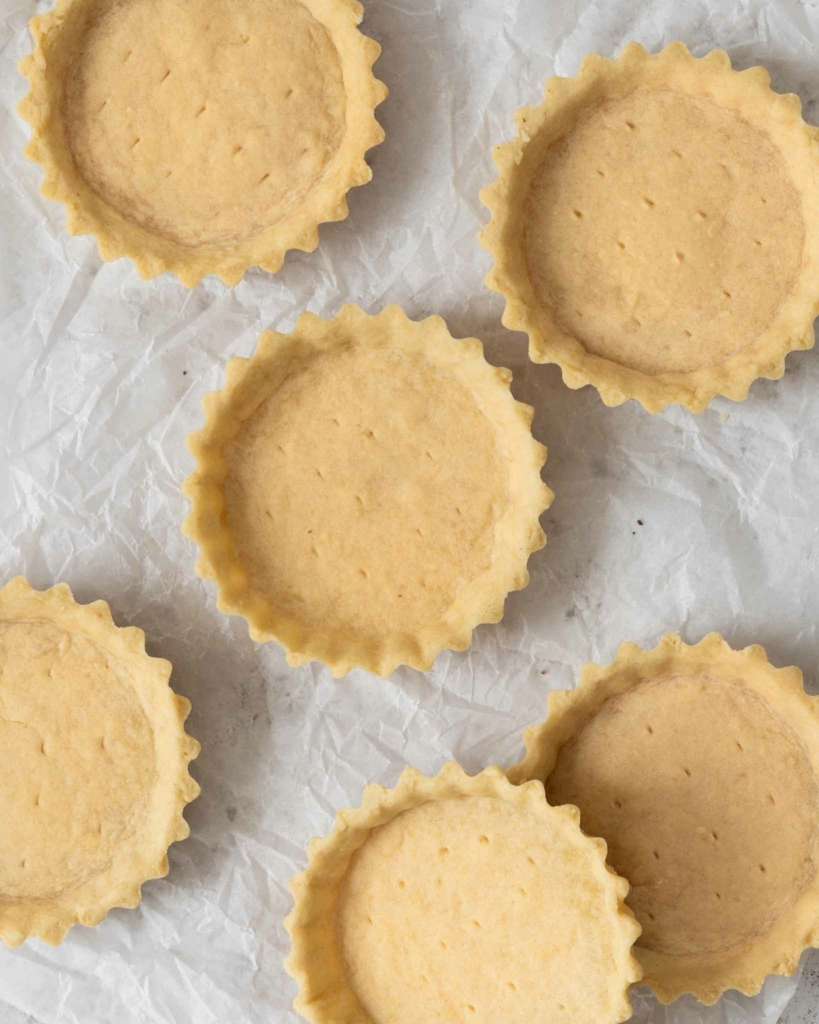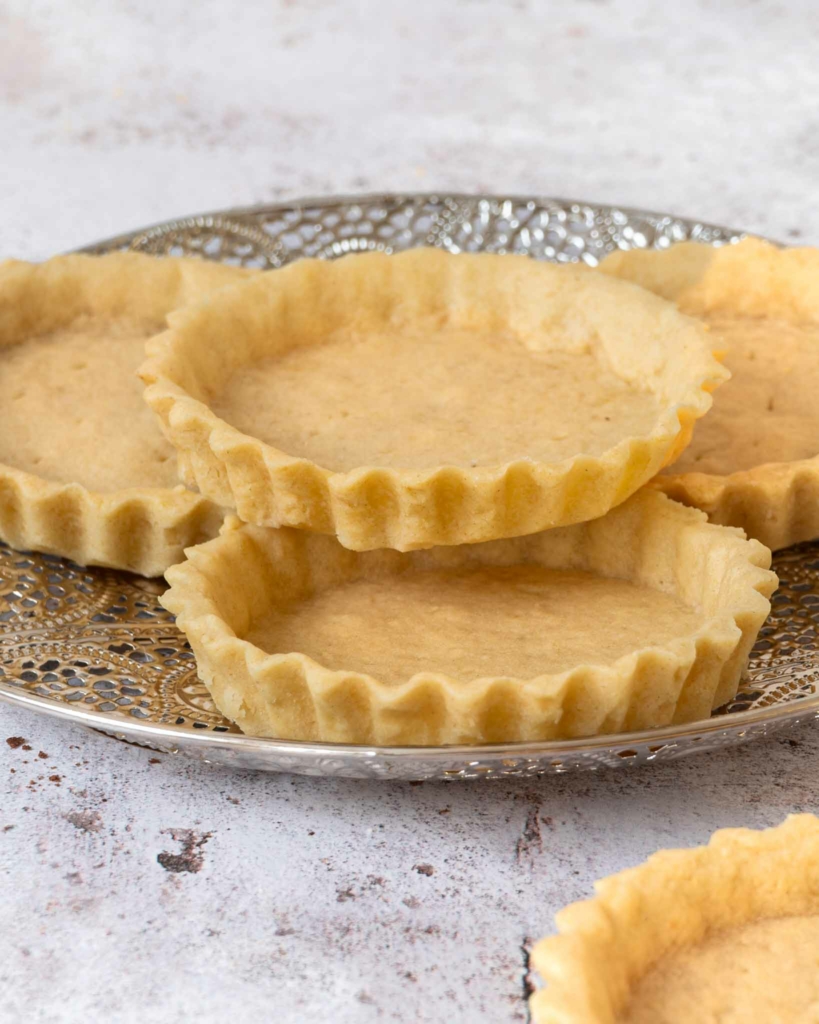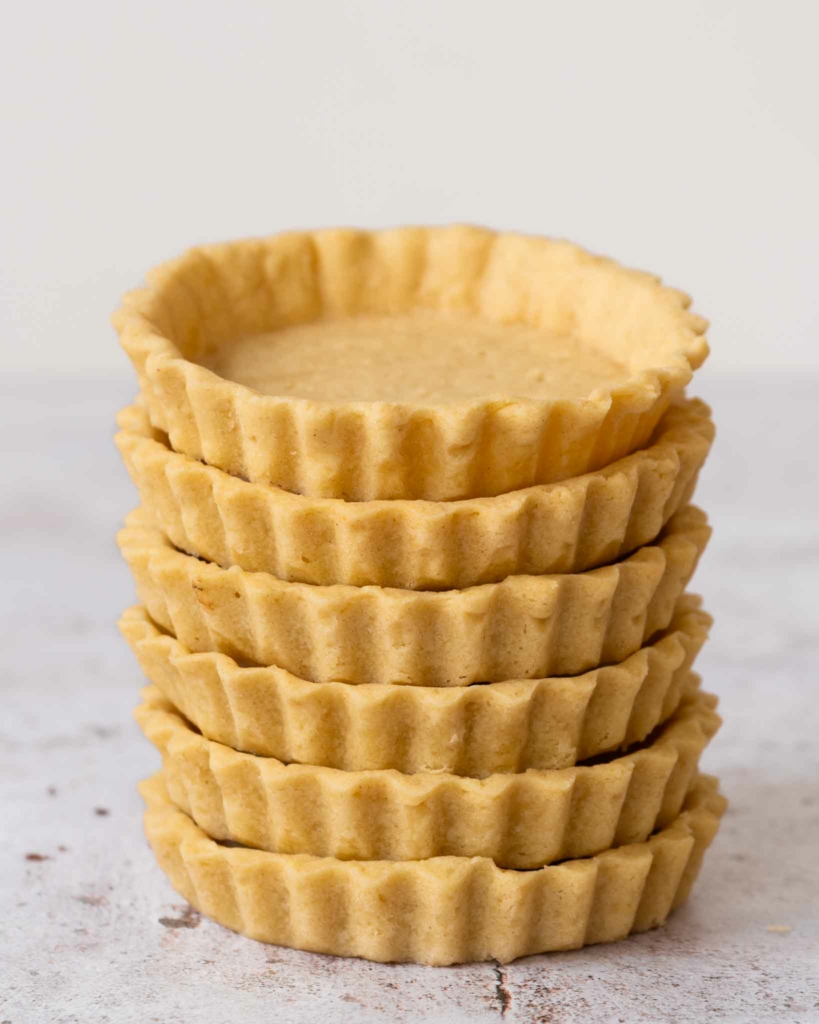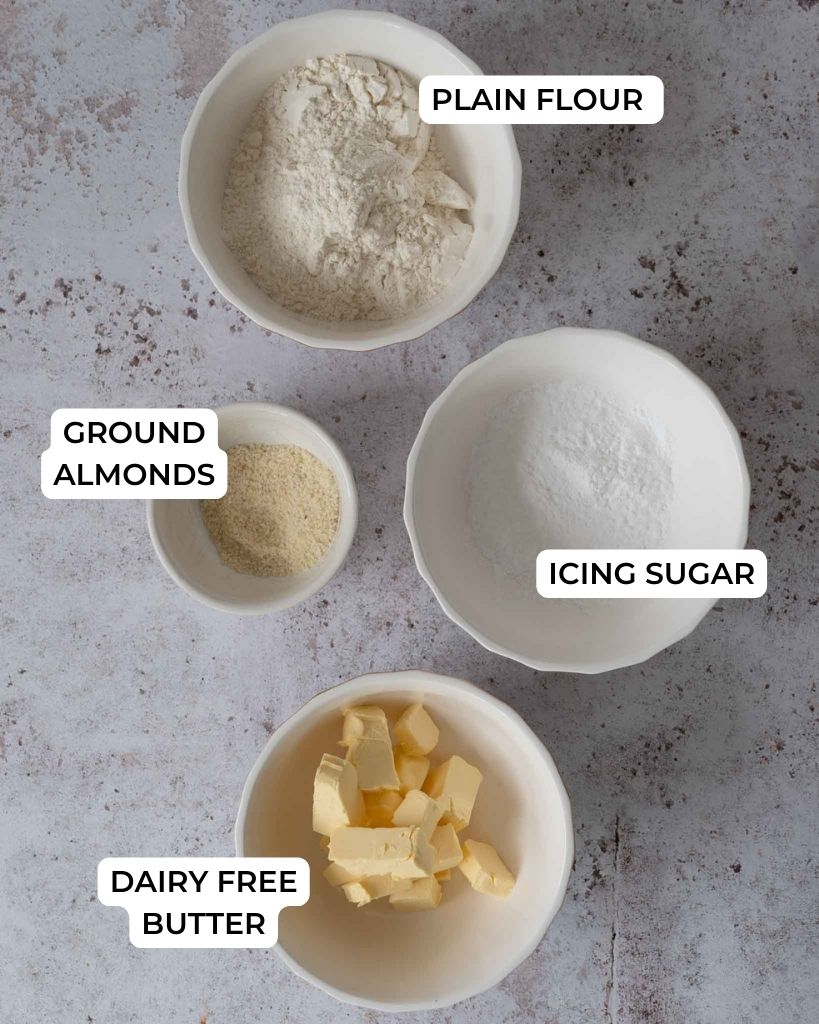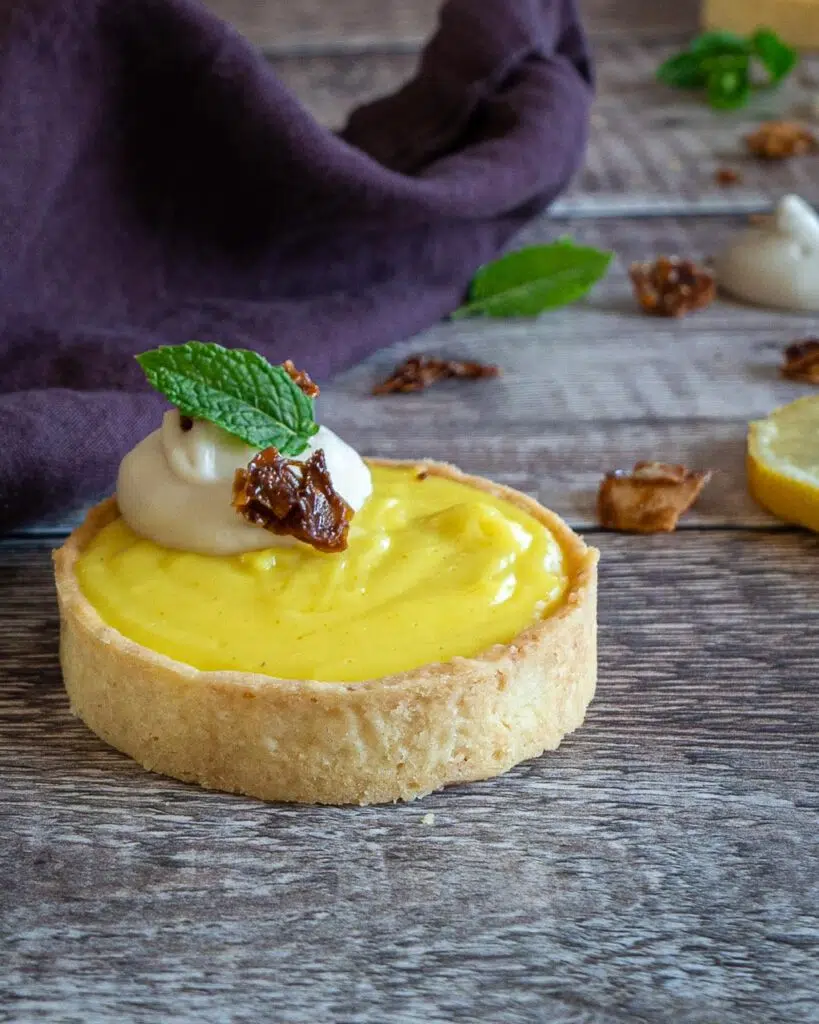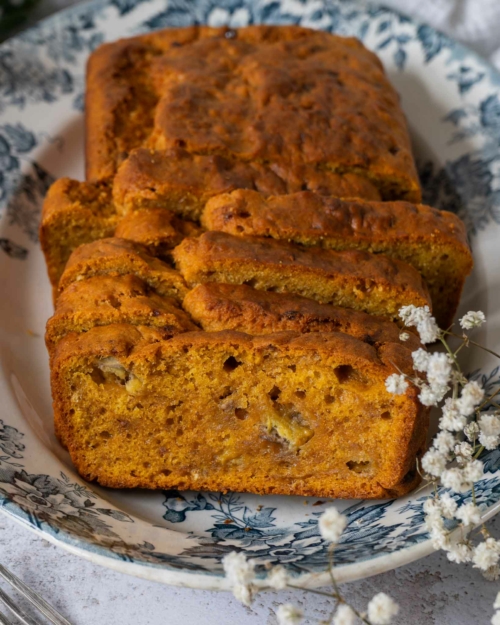Learn how to make simple vegan tart shells with 4 ingredients. These beautiful, crisp pastry tartlet shells are the perfect base for individual desserts such as vegan jam tarts and mini banoffee pies.
These homemade vegan tart shells are light, crisp and buttery. With a melt-in-the-mouth texture and delicately sweet flavour, these vegan tartlet shells are perfect for making individual vegan desserts.
The pastry dough is easy to make, using a food processor for a quick and low-mess method. You’ll need just 4 simple ingredients and less than 20 minutes of active prep time to make these dairy free and egg free tart shells.
Have you ever made vegan pastry before? Whilst it can seem intimidating, making beautiful pastry that is delicate to eat is not as complicated as it may seem. I’m walking you through the process, providing crucial success tips for creating excellent vegan pastry, along with a selection of delicious filling ideas.
Quick Links:
- The written recipe
- Why you’ll love this recipe
- Success tips
- Step by step instructions with photos
- Filling ideas for vegan tart shells
- FAQs
- Other delicious vegan dessert recipes to try
Why you’ll love these Vegan Tart Shells
Easy to make and minimal prep. I use a food processor to make this pastry in two simple steps – 1. Blend the flour, sugar and vegan butter to a breadcrumb consistency and 2. Add cold water and blend for a few seconds until the pastry comes together.
Crisp, light and delicate. I prefer dessert pastry cases to have a crisp, light texture that melts in the mouth. These vegan tartlet shells (a take on vegan pâte sablée) hold their shape and with their buttery, slightly sweet flavour, suit a multitude of dessert fillings.
The pastry can be made in advance. This pastry can be refrigerated for up to 2 days or frozen for up to a month. Ensure that it is wrapped tightly in eco cling film (and ideally placed in an airtight container too), and that it is fully defrosted in the fridge before use.
Success Tips
- Keep everything cold. Perhaps the most important tip when making any shortcrust pastry! Use cold vegan butter and ice cold water when making pastry, and chill your pastry between steps. This will prevent the butter from leaking out and the pastry from collapsing during baking.
- Don’t overwork the pastry. Try not to handle the pastry too much or overwork the pastry (e.g. by kneading it for more than a few seconds) because this can cause your baked pastry to be tough. You’ll need to briefly knead the pastry when it comes out of the fridge to make it easier to roll out but keep this to a couple of seconds.
- Don’t skip the chill time. Chill the pastry for at least 1 hour in the fridge (or 30 minutes in the freezer and then transfer to the fridge) once it comes out of the food processor. Chill it again for 10 minutes once you’ve rolled it out and lined your tart tins. Don’t be tempted to skip this step and don’t let your pastry sit on the side getting warm, otherwise your pastry could turn into a melted mess in the oven.
- For an extra neat finish. Pastry can puff up a little in the oven, which isn’t too much of an issue if you plan to fill the tart shells. However, if you would prefer an extra neat finish, line the unbaked pastry cases with a sheet of parchment paper and fill them with dried beans or rice. Bake for 15 minutes before removing the parchment and dried beans/rice. Continue baking for 3-5 minutes or until the pastry is lightly golden and dry to the touch.
- Bake until lightly golden. Baking time can vary depending on the oven and the size of the tart pan. Bake for 15 minutes before checking the pastry – if it is dry and lightly golden it’s likely ready. If the pastry does not feel dry and/or is still pale, bake for another 2-3 minutes before checking again.
- Did you underbake? Follow this tip! If you take the pastry cases out of the oven and after a few minutes the base starts to look a little dark or damp then they’re probably underbaked. You want them to be dry to the touch and a light golden colour. Fear not though! If you think you’ve taken them out of the oven too soon, just preheat the oven again and pop them back in again for a few minutes so they can finish cooking.
How to make these Vegan Tart Shells
Ingredients
Here’s what you need to make this sweet tart crust:
Plain flour. Also called all purpose flour, or you can use pastry flour.
Icing sugar. Also called powdered sugar. You should not substitute for caster, granulated or brown sugar.
Ground almonds. Used to add a delicate crispness to the pastry.
Dairy-free butter. Use the block kind that you can cut into cubes rather than a spreadable variety. Make sure it’s cold when you use it.
Water. Make sure your water is as cold as possible!
Equipment
You’ll need a food processor, rolling pin and non-stick tart tins (ideally with a removable bottom) to make this recipe for sweet tart shells.
Steps
Make sure to head to the recipe card below for the full recipe and instructions on how to make this vegan tart crust!
Gather together your ingredients and weigh them out. We recommend using electronic scales rather than measuring cups.
Add the ingredients to the bowl of food processor (except the water) and blitz until the mixture resembles breadcrumbs.
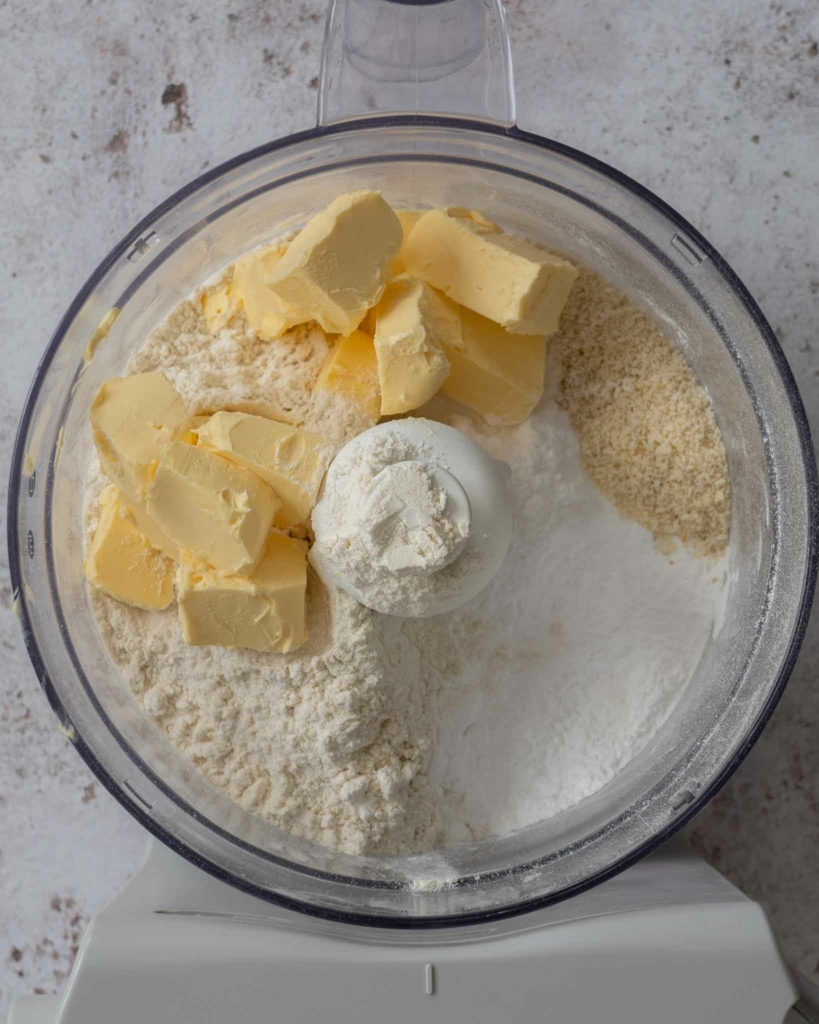
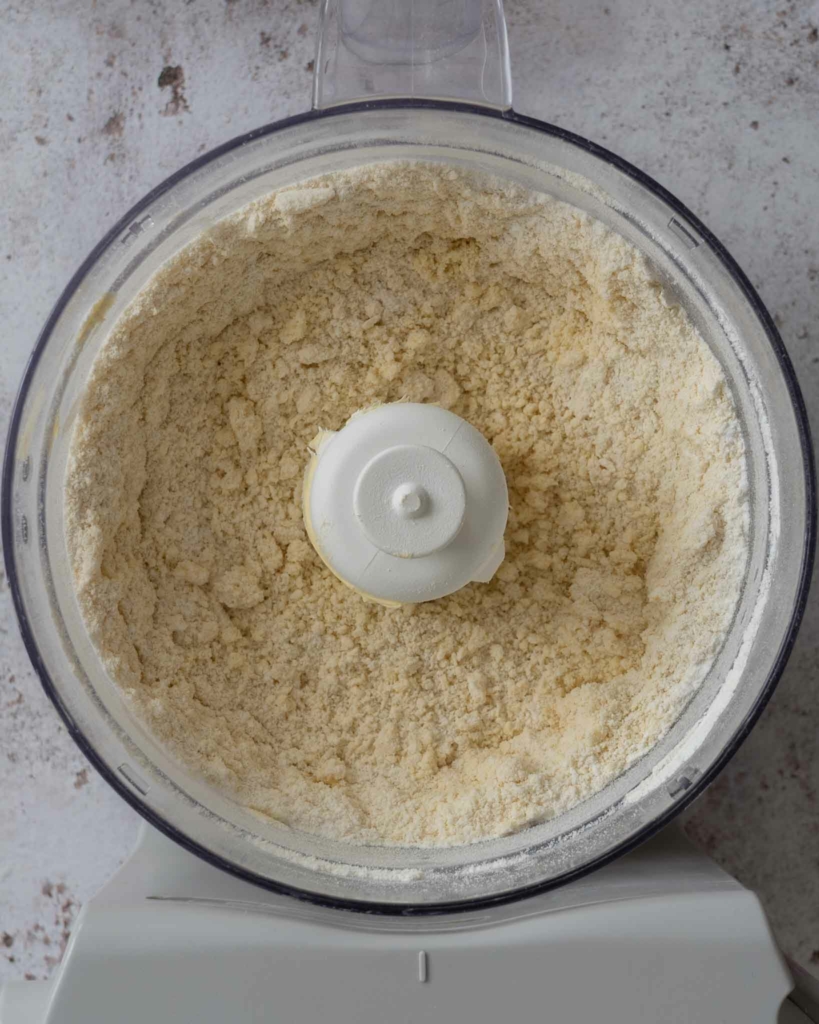
Add the water and blend again for a few seconds. The mixture should then come together when squeezed, and no longer be crumbly.
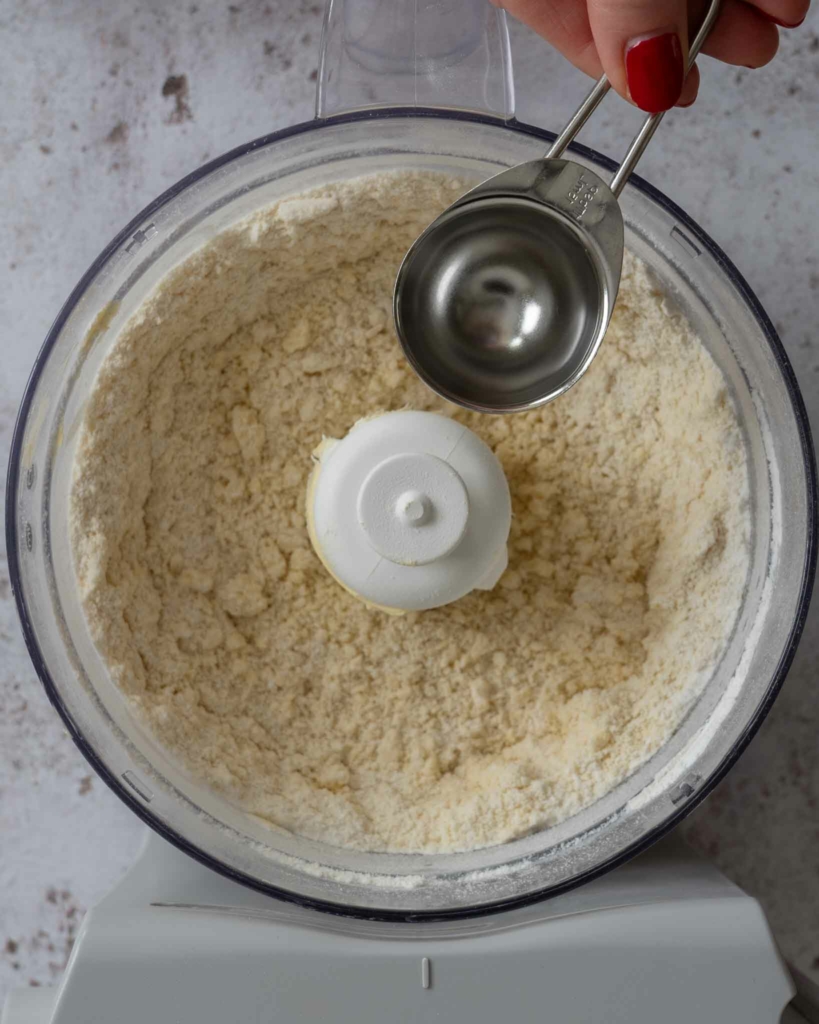

Wrap the pastry dough ball in eco plastic wrap and chill it in the refrigerator for at least 1 hour or freezer for 30 minutes.
Note: Don’t freeze the pastry for more than 30 minutes if you plan to use it today. You can transfer it from the freezer to the fridge after 30 minutes if you’re not quite ready to roll it out.
Note: The pastry can be stored in the fridge for up to 2 days (wrapped tightly in eco cling film and ideally in an airtight container too).
Roll the pastry out on a lightly floured surface to around 3mm thick (1/4cm or 1/8”).
Cut out a piece of pastry dough that is 1-2cm larger than one of your tart tins.

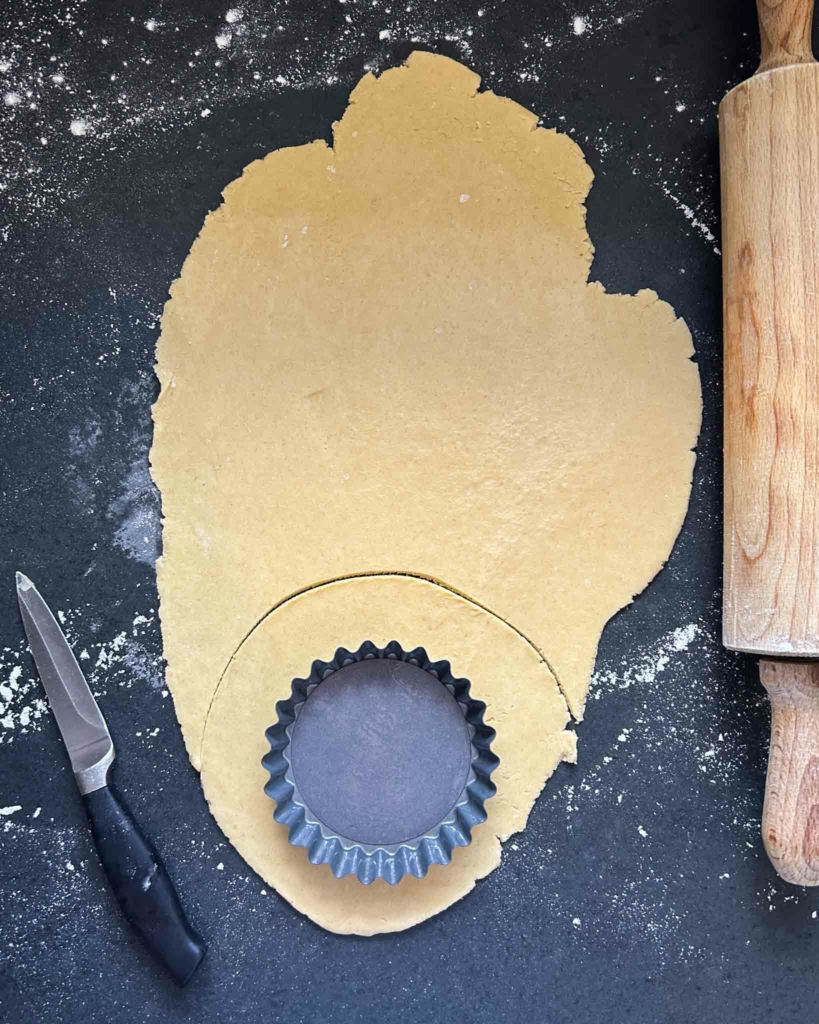
Transfer the pastry to the tart tin and gently press it into place.
Cut off any excess with a sharp knife. You can re-roll any leftover pastry to line additional tart tins.
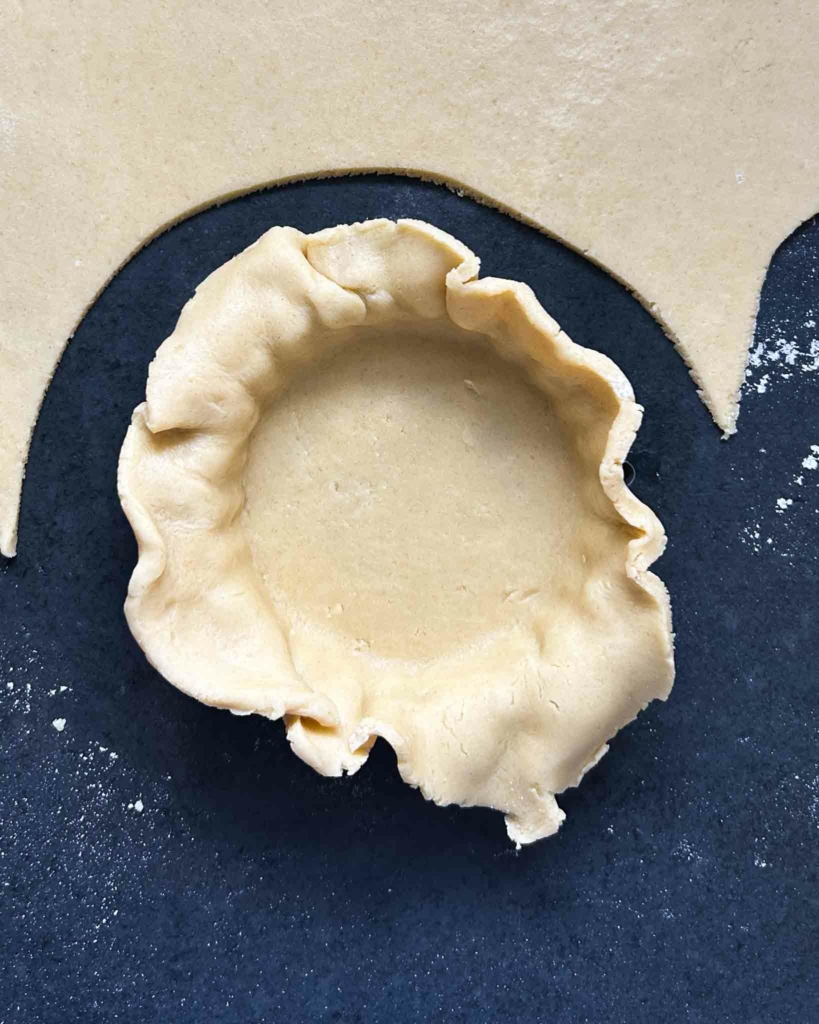
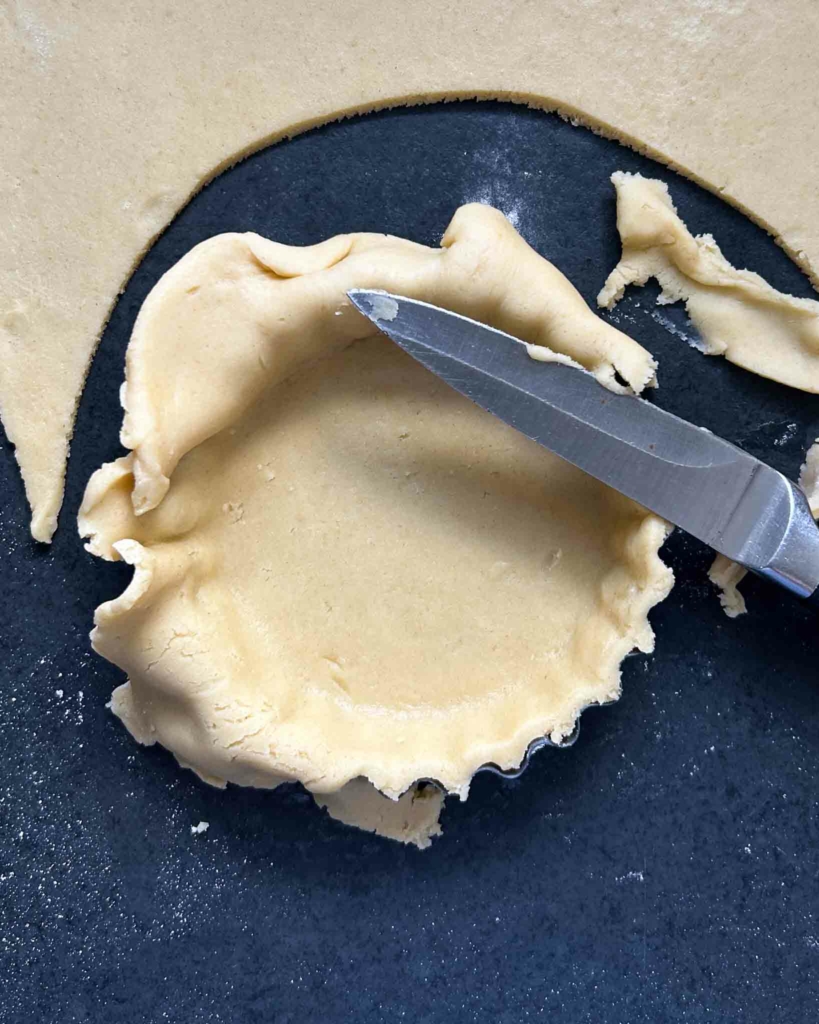
Prick the base with the tip of a knife (or a fork).
Place the tart shells on a baking tray and put them in the fridge to chill for 10 minutes whilst you preheat the oven.
Bake for 15-20 minutes at 150°C (170°C conventional / 325°F / gas mark 3) until the pastry is dry to the touch and lightly golden. Let the pastry cases cool to room temperature in the tins before removing them.

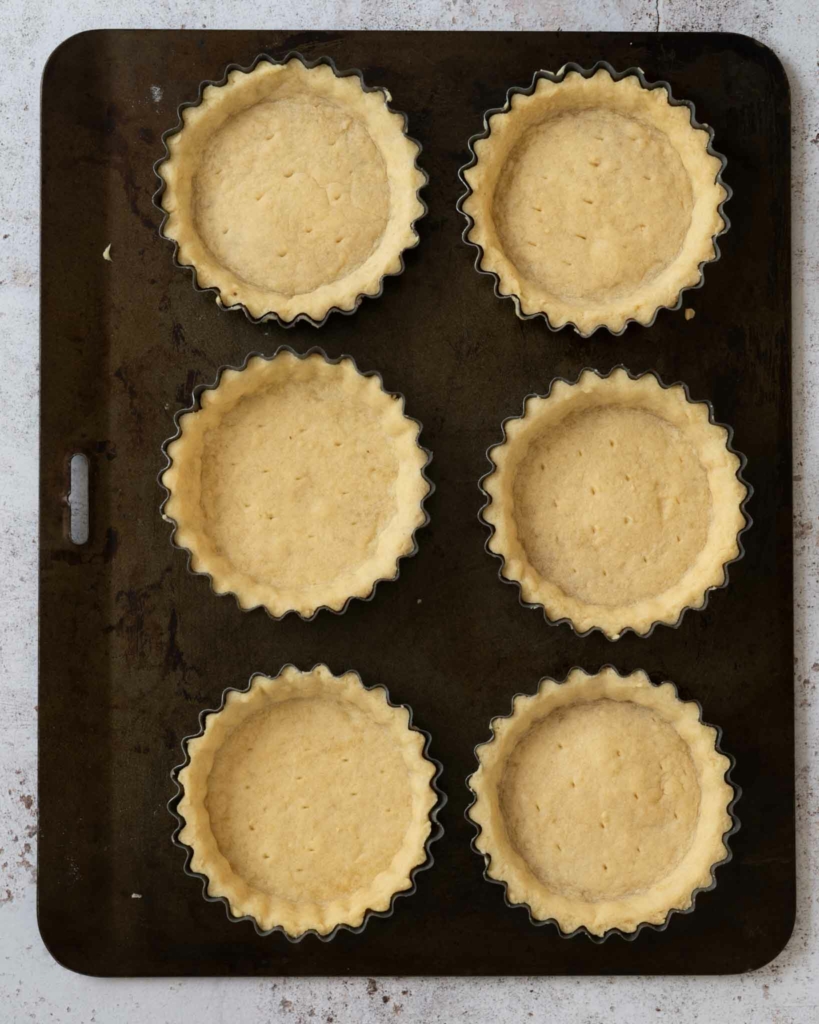
Tart Filling Ideas for Vegan Tart Shells
- Vegan Jam Tarts – Fill these tart shells with tangy raspberry jam and drizzle in dark chocolate for fruity vegan tarts.
- Lemon Tartlets – Make an easy vegan lemon curd and set it in these vegan tartlet shells. Top with whipped coconut cream and curls of vegan chocolate.
- Mini Banoffee Pies – Line these vegan tart shells with sliced banana, top with our easy vegan caramel, whipped vegan cream and grated dark chocolate.
- Vegan Biscoff Tarts – Fill to the brim with Biscoff spread and marble with vegan white chocolate for a sophisticated (but actually very easy!) vegan dessert
- Mini French Chocolate Tarts – Create a vegan chocolate ganache with vegan dark chocolate, milk chocolate and dairy-free cream, set this in these vegan tart shells and top with fresh fruit for pretty chocolate fruit tarts.
FAQs
Can vegans eat pie crust?
Pie crust is typically not vegan because it contains dairy butter and egg in the pastry dough. Pastry is also often glazed with egg yolk to give it a golden, shiny colour. It is possible to make vegan pie crust by substituting dairy butter for non-dairy butter and omitting the egg.
What is a vegan substitute for butter in pie?
It depends on the type of pastry you are making as to the most appropriate substitute for butter in pie crusts. You can generally use vegan block butter or cold coconut oil instead of butter in pie crusts and tart shells. We’ve got several vegan pastry recipes on our blog including:
- This recipe for Vegan Tart Shells – we use vegan butter (the kind you can cut into cubes, not the spreadable variety) to create a firm vegan shortcrust pastry that is perfect for mini tarts where the pastry is baked before being filled.
- Vegan Sweet Shortcrust Pastry – we use coconut oil for a crisp finish in this recipe. It’s perfect for large pies or tarts and can either be blind baked before filling, or filled and then baked.
- Vegan Hot Water Crust Pastry – we use a combination of dairy free spreadable margarine and melted vegetable shortening in this recipe for a traditional sturdy but soft finish to our hot water crust pastry. This pastry is perfect for savory pies.
- A Proper Vegan Cornish Pasty – in this recipe we teach you how to make flaky rough puff pastry using vegetable shortening.
Why put fork holes in pie crust?
Using a fork or knife to prick the base of a pie crust before baking helps to prevent the pastry from rising too much and doming, which leaves less space for filling.
An alternative to this method is to ‘blind bake’ the tart shells, which we describe below.
What is ‘blind baking’ tart shells?
Blind baking tart shells involves baking the pastry before adding the filling, which we recommend when making tart shells.
One method is to put the unbaked pastry cases into the oven, without anything in them. Pricking the base can prevent the pastry from rising too much or doming in the middle (leaving less room for a filling).
Another method, if you’re looking for a particularly neat finish, is to line the unbaked pastry with parchment paper and fill the tart shells with pie weights, dried beans or rice. This weighs down the pastry whilst it bakes, preventing it from rising and resulting in a neater finish.
You should remove the parchment paper and beans/rice a few minutes before the end of baking, to allow time for the pastry to finish baking and turn lightly golden. Blind baking using this method of parchment paper and dried beans will likely add a couple of minutes onto the bake time compared to the other method of blind baking without any dried bean filling to weigh down the pastry.
Can I make this pastry in advance?
If you’re not ready to bake your pastry just yet, you can wrap the dough up and either pop it in the fridge for up to 2 days, or freeze it for up to a month. Just defrost it fully in the fridge for 24 hours before use.
Loved these Vegan Tart Shells? Here are some more delicious vegan recipes to try:
I hope you LOVE this recipe for vegan tart shells! Please share this recipe with someone you think will also enjoy it because it’s our goal to encourage as many people as possible to try plant based eating.
Also, don’t forget to tag @aveganvisit on social media when you make this recipe. I absolutely love seeing your re-creations! Enjoy 🙂 x
If you make this recipe, please leave a comment and star rating below – this provides helpful feedback to both me and other readers. If you want more delicious vegan recipes be sure to subscribe to the A Vegan Visit newsletter. We’d also love for you to join the AVV community on Youtube, Tiktok, Instagram, Pinterest and Facebook.
The Written Recipe:

How to Make Vegan Tart Shells (Easy Pastry Recipe)
Ingredients
- 160 g plain flour (or pastry flour)
- 50 g icing sugar (or powdered sugar)
- 10 g ground almonds
- 100 g dairy free butter (the block kind, cut into cubes)
- 1 tbsp water (ice cold)
Instructions
- Blitz the ingredients. Add all of the ingredients, except the water, into a food processor and blitz until the mixture resembles breadcrumbs. This should take approximately 20 seconds.160 g plain flour, 50 g icing sugar, 10 g ground almonds, 100 g dairy free butter
- Add the water. Add 1 tbsp cold water to the mixture and blitz again briefly for approximately 10 seconds. Take a small handful of the mixture and squeeze it together in your hand - if the mixture comes together into a ball then it’s ready, if it’s crumbling apart then add another tsp of water and blitz again before testing once more.1 tbsp water
- Chill the pastry. Remove the mixture from the food processor and bring it together into a ball. Press it down to flatten it slightly, wrap it tightly in eco cling film and either refrigerate it for 1 hour or freeze it for 30 minutes.Note: Chilling the pastry before baking prevents the butter from leaking out during baking.Note: Don't freeze the pastry for more than 30 minutes if you plan to use it today. You can transfer it from the freezer to the fridge after 30 minutes if you're not quite ready to roll it out.
- Prepare to roll out the pastry. Once the pastry has been chilled, transfer the dough to a lightly floured surface. Knead the dough briefly for a couple of seconds to make it easier to roll out.
- Roll out the dough. Lightly dust a rolling pin with flour and then roll the pastry dough out to around 3mm thick (1/4 cm or 1/8"). If you roll the pastry thinner than this then it is more likely to tear, if you roll the pastry thicker than this it may not cook through properly.
- Prepare the baking tins. Spray a light coating of spray oil onto non-stick tartlet tins (with removable bases) to prevent the pastry from sticking and to make it easier to remove the tart shells from the tins once baked.Note: We used six round 9cm (3.5”) tartlet tins with removable bases.
- Transfer the dough. Roughly cut out a piece of pastry dough that is 1-2cm larger than one of your tart tins. Transfer this piece of dough to the tart tin and gently press it down into the tin. Trim off any excess with a sharp knife.Note: If you have any mishaps along the way, don’t worry, this pastry is forgiving - just patch it up as necessary, using spare pastry to fill any holes. Use a small piece of rolled-up pastry to gently press the pastry into the tart tin.
- Repeat. Repeat this process with the remaining tart tins, re-rolling remaining pastry as necessary until it has all been used.
- Chill the pastry. Place all of the tart tins onto a baking tray and then lightly prick the base of the pastry cases with a fork . Place the tray into the fridge to chill for 10 minutes whilst you preheat the oven.
- Bake. Preheat the oven to 150°C fan (170°C conventional / 325°F / gas mark 3). Place the pastry cases into the oven to bake for around 15 minutes. Check the pastry cases - if the base feels dry to the touch and the pastry has started to pick up a bit of a golden colour then they are likely ready. If the pastry does not feel dry and is still pale, bake for another 2-3 minutes before checking again.Note: Baking time can vary depending on the oven and the size of the tart tins being used.Note: The pastry can puff up a little in the oven, which isn’t too much of an issue if you plan to fill the tart shells. However, if you would prefer an extra neat finish, line the unbaked pastry cases with parchment paper and fill them with dried beans or rice. Bake for 15 minutes before removing the parchment and dried beans/rice. Continue baking for 3-5 minutes or until the pastry is lightly golden and dry to the touch.
- Cool. Let the pastry cases cool to room temperature in the tins before removing them.
- Storing the pastry. If you’re not ready to bake your pastry just yet, you can wrap the dough up and either pop it in the fridge for up to 2 days, or freeze it for up to a month. Just defrost it fully in the fridge for 24 hours before use.

